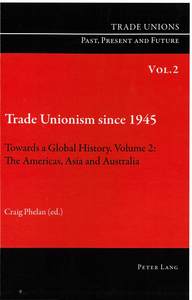Trade unionism in Singapore since 1945
Leggett, Christopher (2009) Trade unionism in Singapore since 1945. In: Phelan, Craig, (ed.) Trade Unionism Since 1945: towards a global history. Volume 2: the Americas, Asia and Australia. Trade Unions Past, Present and Future, 2 . Peter Lang, Bern, Switzerland, pp. 187-219.
![[img]](https://researchonline.jcu.edu.au/16075/1.hassmallThumbnailVersion/16075_Leggett_2009_Cover.jpg)
|
Image (JPEG) (Book Cover)
- Cover Image
Download (206kB) |
|
|
PDF (Published Version)
- Published Version
Restricted to Repository staff only |
Abstract
[Extract] The island city state of Singapore is less than 700 square kilometres but possesses a deep natural harbour and is strategically positioned in the Straits of Malacca at the southern end of the Malay Peninsula, to which it is joined by a causeway and a bridge. It was ceded to the British East India Company by the resident sultan in 1824, and formed part of the Straits Settlements from 1826 to 1867 before becoming a Crown Colony under the British Colonial Office from 1867 to 1941, when it was invaded and occupied by the Japanese. Following the return of British authority in 1945 Singapore experienced the turbulence of an anti-colonial struggle, during which there was a state of 'Emergency', until it was granted partial self-government in 1955 and full self-government in 1959, when the People's Action Party (PAP) was elected to office. Singapore joined the Federation of Malaysia in 1963, but left in 1965 to become an independent republic within the Commonwealth of Nations. The PAP has been returned to office at every general election since 1959 and has overseen the industrialisation and economic development of Singapore. The crises for Singapore of its separation from Malaysia, the departure of the British military in the late 1960s, the world oil price hikes of the 1970s, the recession of 1985-6, and the Asian financial problems of 1997 each strengthened the PAP's political resolve and reinforced its avowed pragmatism. Singapore's population growth under colonial rule comprised mostly indentured labourers from southern China and, to a lesser extent, from southern India. Ethnic Malays and Chinese from older settlements in the Malay Peninsula and archipelago also contributed to population growth.
| Item ID: | 16075 |
|---|---|
| Item Type: | Book Chapter (Research - B1) |
| ISBN: | 978-3-03911-950-9 |
| ISSN: | 1662-7784 |
| Keywords: | labour unions, industrial relations, history |
| Date Deposited: | 03 Aug 2011 06:30 |
| FoR Codes: | 15 COMMERCE, MANAGEMENT, TOURISM AND SERVICES > 1503 Business and Management > 150306 Industrial Relations @ 100% |
| SEO Codes: | 91 ECONOMIC FRAMEWORK > 9104 Management and Productivity > 910401 Industrial Relations @ 100% |
| Downloads: |
Total: 356 Last 12 Months: 5 |
| More Statistics |



